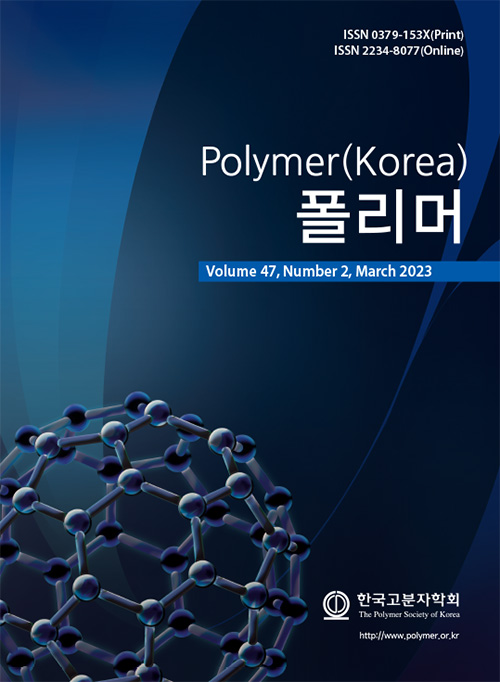- Double-Layer Wound Dressing Consisting of an Upper Layer of Robust Polyurethane/Polycaprolactone and a Lower Layer of Biodegradable Polycaprolactone/Gelatin/Cellulose
Department of Biomedical Engineering, Daelim University, Anyang 13916, Korea
- 기계적 물성이 우수한 폴리우레탄/폴리카프로락톤 상층과 생분해성 폴리카프로락톤/젤라틴/셀룰로오스 하층으로 구성된 이중층 상처드레싱
대림대학교 보건의료공학과
Reproduction, stored in a retrieval system, or transmitted in any form of any part of this publication is permitted only by written permission from the Polymer Society of Korea.
Becausesingle-layer wound dressings cannot meet all clinical needs due to the complexity of the skin, a bilayer scaffold was synthesized by electrospinning a polyurethane/poly(caprolactone) (PU/PCL) top layer onto a spun PCL/gelatin/cellulose fiber (P/g/CF) sublayer using a common solvent to evaluate the feasibility of the scaffolds as a wound dressing. When the PU/PCL top layer was spun onto a P/g/CF sublayer, the tensile strength of the bilayer scaffold increased from 4.29 MPa to 6.34 MPa by adding a PU/PCL layer. Although the highest moisture vapor transmission rate (MVTR) and water uptake capacity (WUC) values were observed for PU/PCL and P/g/CF scaffolds, respectively, the appropriate MVTR and WUC values make all scaffolds applicable for wound dressings. Bilayer scaffold have potential applications in wound dressings due to their mechanical properties, MVTR, WUC, porosity, cell viability and proliferation.
단일층의 상처드레싱은 피부의 복잡성으로 인해 모든 임상 요구를 충족시킬 수 없다. 그렇기 때문에 이중층 스캐폴드의 상처드레싱이 사용된다. 전기방사를 이용하여 제조한 이중층 스캐폴등 상처드레싱은 하층에 폴리카프로락톤/젤라틴/셀루로오스(P/g/CF)를, 상층에 폴리우레탄/폴리카프로락톤(PU/PCL)으로 구성된다. P/g/CF에 PU/PCL을 전기방사함으로 스캐폴드의 기계적 강도는 4.29 MPa에서 6.34 MPa로 증가하였다. PU/PCL과 P/g/CF 단일지지체에서 최적의 투습도와 수분흡수도가 각각 관찰되었지만, 모든 지지체들은 상처드레싱에 적합하였다. 이중층 스캐폴드는 기계적 특성, 투습도, 수분흡수도, 세포생존률 및 증식이 상처 드레싱으로 사용하기에 적합하였다.
Keywords: wound dressing, bilayer scaffold, electrospinning, polyurethane, polycaprolactone.
- Polymer(Korea) 폴리머
- Frequency : Bimonthly(odd)
ISSN 0379-153X(Print)
ISSN 2234-8077(Online)
Abbr. Polym. Korea - 2022 Impact Factor : 0.4
- Indexed in SCIE
 This Article
This Article
-
2023; 47(2): 151-156
Published online Mar 25, 2023
- 10.7317/pk.2023.47.2.151
- Received on Oct 25, 2022
- Revised on Dec 7, 2022
- Accepted on Dec 28, 2022
 Correspondence to
Correspondence to
- Deuk Yong Lee
-
Department of Biomedical Engineering, Daelim University, Anyang 13916, Korea
- E-mail: dylee@daelim.ac.kr










 Copyright(c) The Polymer Society of Korea. All right reserved.
Copyright(c) The Polymer Society of Korea. All right reserved.